LAV II armored vehicles in service
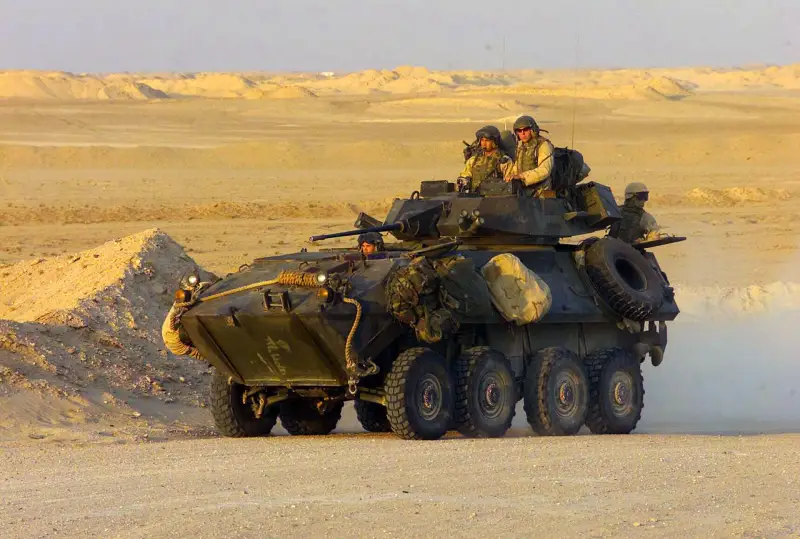
LAV-25 during one of the operations of recent decades
In the early eighties, a new family of wheeled armored fighting vehicles, the LAV II, was developed for the US Marine Corps. They soon entered service and subsequently became one of the foundations of the ILC fleet. LAV II of all models were repeatedly used in real military operations and performed well. However, after several decades of service, these machines have become obsolete and need to be replaced, for which a corresponding program was recently launched.
Early stages
History The LAV (Light Armored Vehicle) family began in 1981. Then the Pentagon considered that the existing fleet of ILC armored vehicles was obsolete and needed a radical update. After the necessary preparation, in April 1981, tactical and technical requirements for a promising armored personnel carrier for Marines were released and a corresponding competition was launched.
One of the participants in the LAV program was General Motors Canada (GMC). Since the mid-seventies, it has produced LAV armored personnel carriers for the Canadian army, a licensed version of the Swiss MOWAG Piranha. Based on this sample, the LAV II product was developed for the USMC. A successful platform and its competent modification taking into account the requirements of the new customer have become competitive advantages.
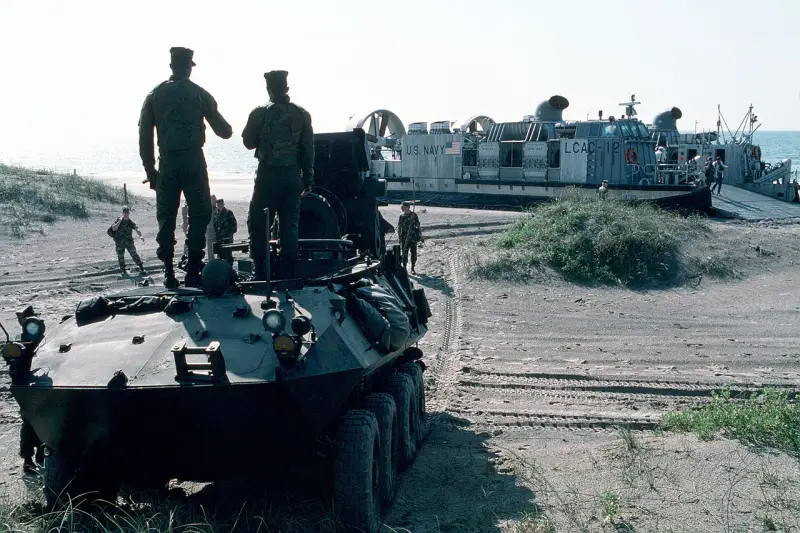
Self-propelled ATGM LAV-AT after unloading from a landing boat, 1989
In September 1982, the GMC project was announced as the winner of the LAV competition. At the same time, the company was given a contract to produce 969 armored vehicles for the Marine Corps. In addition, at this stage the US ground forces became interested in the LAV program. They submitted a request to the military budget for the purchase of 2350 new armored personnel carriers, but Congress did not approve it. As a result, KMP remained the only buyer of the new equipment.
Serial equipment began to arrive in the ILC units already in 1983, and by the end of the year the first units reached the stage of initial operational readiness. Production continued, and over the next few years the fleet of all major parts and connections was updated. At the same time, already during production it was necessary to revise previously approved plans. Thus, due to rising costs and cost reductions, the series sizes decreased to 758 units.
Vehicle family
In accordance with customer requirements, GMC has developed a unified wheeled chassis, as well as several options for equipping it with different functions and capabilities. Seven variants of the LAV II were put into production. Several more have not progressed beyond development and testing.
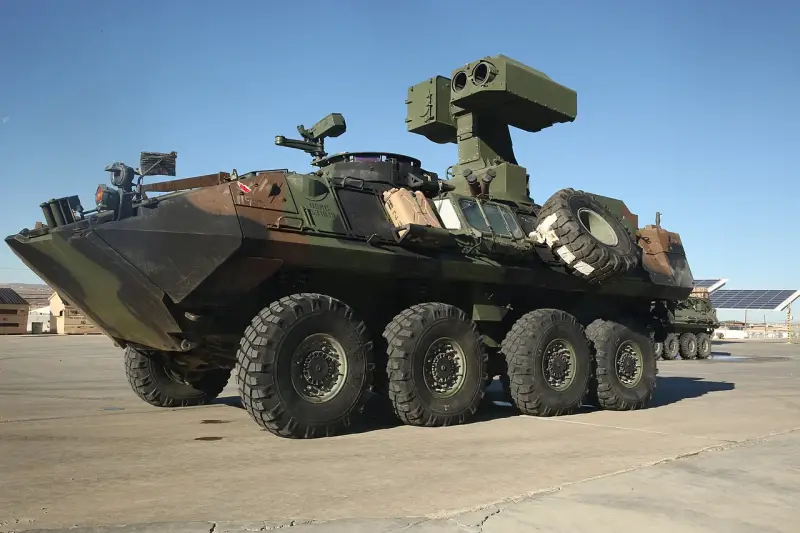
Upgraded version of LAV-AT
The LAV II chassis is a four-axle wheeled vehicle 6,4 m long and 2,5 m wide with the ability to achieve a combat weight of up to 12,5-13 tons. The welded armored hull provides protection against 7,62 mm machine gun bullets and shrapnel with comparable energy. Installation of overhead protection is possible. The layout is traditional for equipment of this class. In the bow on the left is the control compartment; to the right of it is the engine compartment. The central and rear parts of the hull are given over to the combat and troop compartments.
Dimensions and weight allow the LAV II to be transported by different vehicles. The armored vehicle is part of the main US Air Force C-130 military transport aircraft and larger models. It can also be transported by LCAC landing craft and other watercraft.
The LAV II power plant is based on a Detroit Diesel 6V53T diesel engine with a power of 300 hp. and Allison MT653 transmissions. The transmission provides all-wheel drive. The maximum speed on the highway is stated at 100 km/h, the range is more than 600-650 km. The aft part of the hull is equipped with propellers for moving through bodies of water.
The most popular in the family is the LAV-25 armored personnel carrier/infantry fighting vehicle. This example is equipped with a full enclosed turret housing an M25 242mm gun and an M240C coaxial machine gun. There is a second machine gun on the roof of the tower. Ammunition 420 shells (150 ready for use) and 1320 rounds. The crew includes 3 people, the landing party - 6 people.
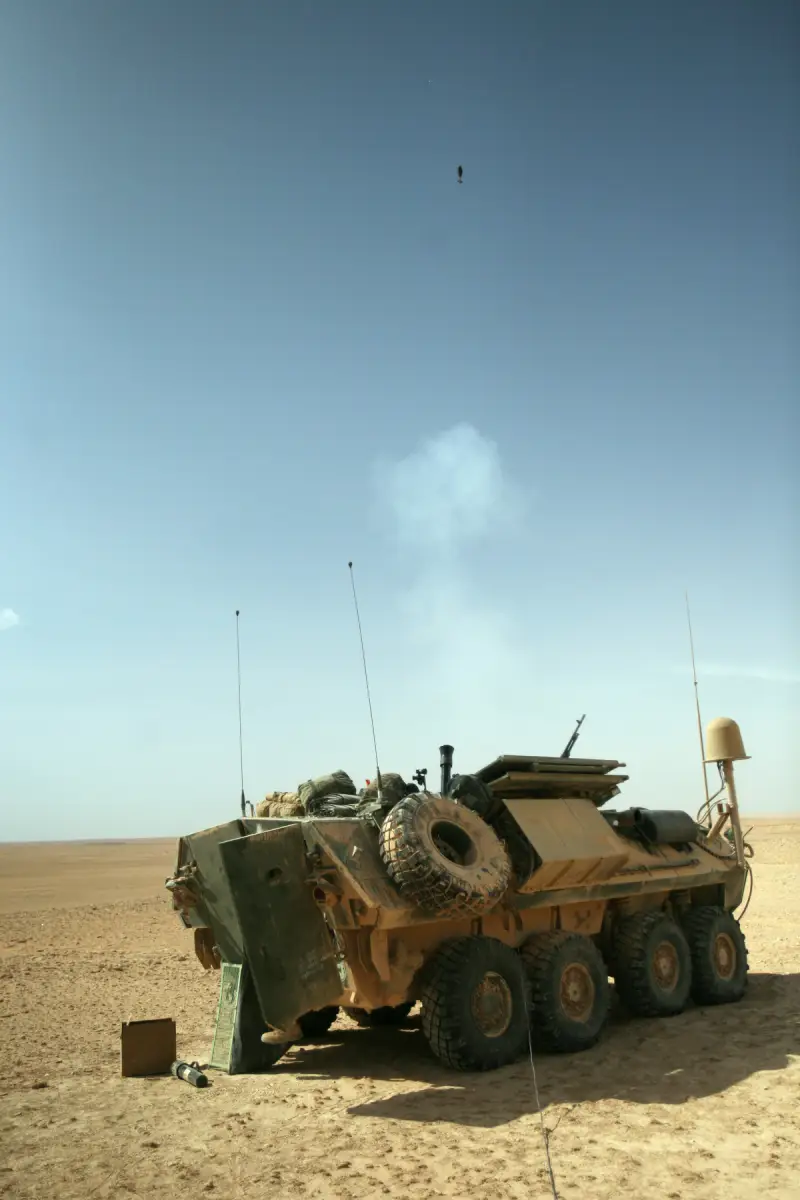
Self-propelled mortar LAV-M
Since the late nineties, the LAV-25 has undergone several upgrades. These projects included strengthening protection through mounted modules, replacing fire control devices, etc. The latest modification of the LAV-25A3 was created at the end of the tenth years, and to date, part of the fleet has undergone appropriate modernization.
The LAV-AT product is a self-propelled anti-tank missile system. This vehicle was originally equipped with TOW 2 missiles on a 901A1 launcher and a 7,62 mm machine gun. Ammunition includes 16 missiles and 1000 rounds of ammunition. Later, the standard launcher was replaced with a new device with improved characteristics and instrumentation.
The family also includes the LAV-M self-propelled mortar. This vehicle is armed with an M81 252mm mortar and a machine gun for self-defense. The mortar is located inside the housing; shooting is carried out through the hatch in the roof. Ammunition - 99 mines. During the recent modernization, the LAV-M received new control devices and a standard UAV for reconnaissance and fire adjustment.
By removing the weapons and increasing the height of the troop compartment, the LAV-C2 command and staff vehicle was created. It houses several automated workstations, an expanded set of communications equipment and other devices for managing the department.
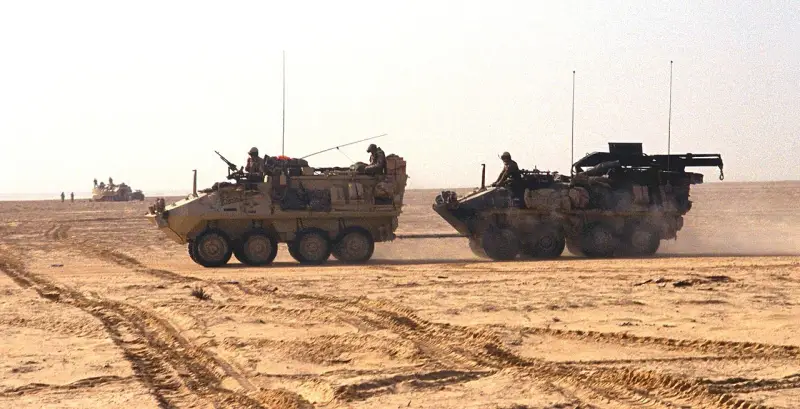
Transport vehicle LAV-LOG and repair and recovery vehicle LAV-R
In a similar way, they built a protected LAV-LOG truck, designed for transporting various property. The LAV-R repair and recovery vehicle was also produced with a winch and crane, as well as a set of tools and spare parts.
Marine units must accompany LAV-MEWSS self-propelled electronic reconnaissance/warfare systems. Such equipment was mass-produced, but its quantity and operating capabilities are unknown.
The LAV-AD self-propelled anti-aircraft missile and gun system did not reach production. This vehicle received a special turret with a radar, a five-barreled 25 mm GAU-12 cannon and FIM-92 missiles. The ammunition load included 16 missiles (8 ready for launch) and 990 shells. Another unsuccessful project was LAV-AG. It provided for the use of a combat module with a 105-mm EX-35 rifled gun. Work on such a self-propelled gun was suspended and resumed, but in the end it was completely stopped. It is also known about unsuccessful attempts to introduce a new 120-mm self-propelled mortar into the LAV family.
Equipment in operation
During the eighties, the USMC received and mastered the equipment of the LAV-25 family. By the end of the decade, all formations and units in need of fleet renewal received it. Lightly armored battalions switched to the new family, each of which was entitled to about a hundred vehicles of all modifications. A little more than half of this number were armored personnel carriers with a 25-mm cannon.
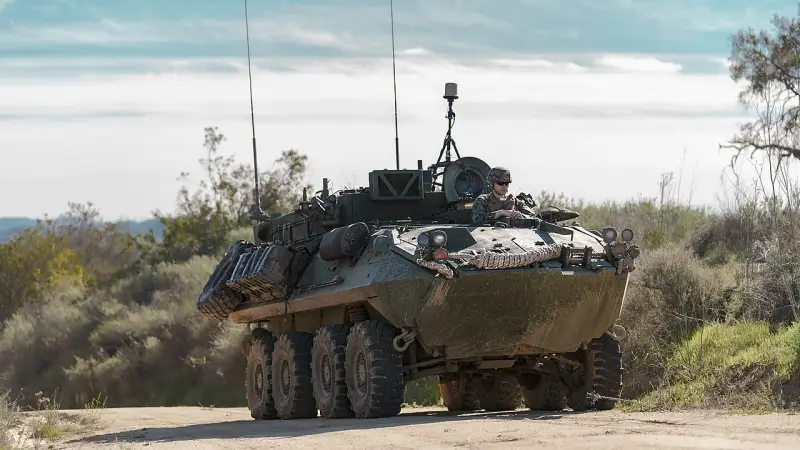
Electronic warfare complex LAV-MEWSS
The new line of armored vehicles first went into battle at the turn of 1989-90, during the American invasion of Panama. The KMP participated in this operation with two companies on LAV-25. They were tasked with blocking certain areas in order to ensure the operation of other formations, as well as the protection of American facilities.
In 1991, units and formations of the Marine Corps took part in Operation Desert Storm, and this time there was a full-scale combat use of new equipment. In general, the LAV II vehicles performed well and effectively solved the problems of transporting and supporting soldiers. However, there were losses, both from the enemy and from friendly fire. Bulletproof armor could not protect against rockets or artillery shells.
During the nineties, the American contingent with the participation of Marines on the LAV II served in various countries and participated in various peacekeeping operations. The equipment did not have to participate in heavy battles, and the service was reduced mainly to patrolling and displaying the flag. In such conditions, the armored vehicles of the family showed their best performance.
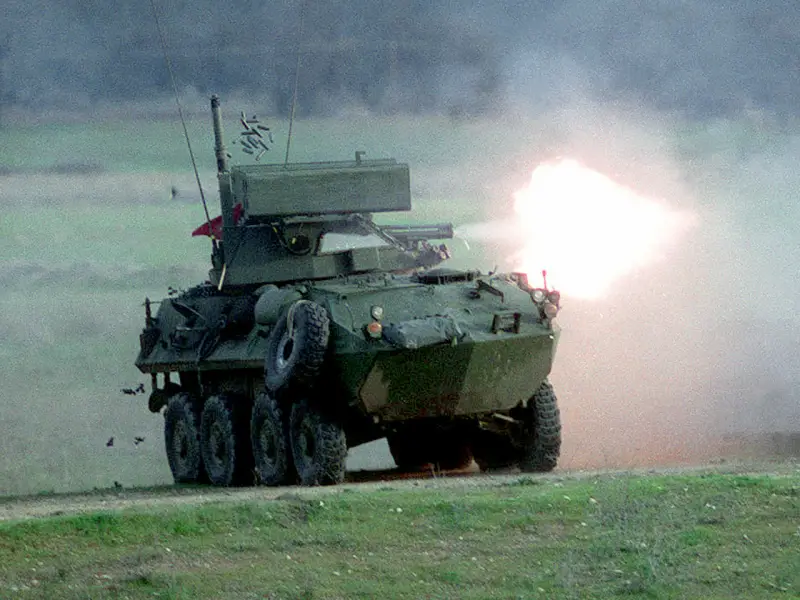
ZRPK LAV-AD during testing, 1999
At the beginning of the next decade, after the first major modernization, LAVs were involved in operations in Afghanistan. The course of hostilities and counter-guerrilla activities showed the correctness of the modernization carried out. At the same time, however, a serious threat remained from anti-tank weapons and explosive devices, due to which losses again occurred.
LAVs of all types were later used in the second intervention in Iraq. Modernization of equipment, changes in the situation on the battlefield and other factors made it possible to obtain generally acceptable results. However, subsequent events and the transition from military operations to police operations had certain negative consequences. At this stage, the equipment became obsolete and the question arose about its new modernization or future replacement.
Replacement issue
Currently, the USMC has several hundred armored vehicles of the LAV II family in service. In recent decades, they have been modernized according to current projects and can continue to serve. According to current plans, this equipment will remain in service until the mid-thirties, and only by this time its replacement will begin.
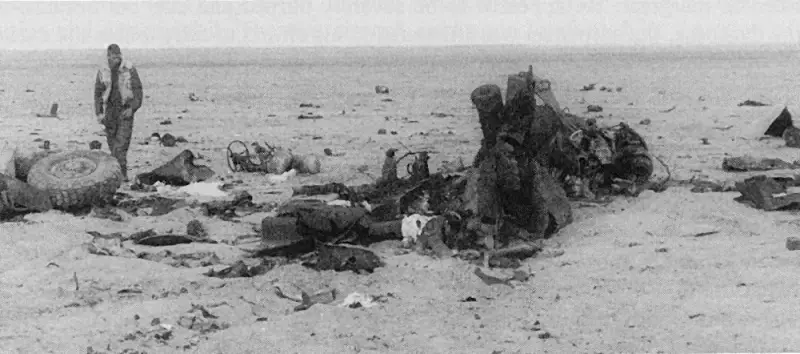
The remains of an LAV-25 armored personnel carrier hit by friendly fire from a TOW ATGM, 1991. The design was simply not designed for such threats and attacks
At the end of the tenth years, a program was launched to develop a promising family of equipment for the ILC called the Armored Reconnaissance Vehicle (ARV). In the early twenties, the requirements and plans were seriously revised, but we are still talking about a new platform and machines for various purposes based on it. Full-fledged samples of new types are expected at testing sites in the middle of this decade.
Not a replacement, but an addition to the existing LAV IIs are the Amphibious Combat Vehicle (ACV). Amphibious armored personnel carriers of this type have been produced since 2020, and to date the ILC has received more than 200 units. In the future, new orders may appear, and the share of such equipment in the troops will increase.
Two promising programs for the development and production of new equipment for the ILC are successfully continuing and are producing the desired results. However, despite all their progress, the LAV II line of equipment retains its place in the troops, and this situation will not change in the coming years. According to current plans, it will serve for another 10-12 years until complete rearmament occurs.
Information